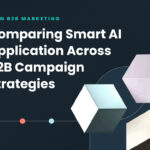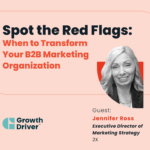In today’s B2B marketing landscape, there’s no one-size-fits-all approach to driving revenue. You might lead with ABX. You might be building demand. Maybe product-led growth or community is your edge—or you’re leaning into lead gen and outbound. Whatever your motion, if it’s aligned with your business goals, you’re on the right track.
The same principle applies to AI.
AI is not a plug-and-play solution—it’s an amplifier. Where and how you apply it should directly reflect the GTM strategy you’re executing. Below, we break down how AI can power smarter execution across five of the most common B2B marketing strategies.
1. ABX: The Art of Personalization at Scale
Account-based experiences (ABX) require precision and personalization. But when every message, landing page, and offer needs to be tailored to specific accounts or personas, costs rise fast—and timelines stretch even faster.
This is where AI becomes a force multiplier. With well-structured prompts, persona-specific insights, and industry intelligence, AI can:
- Draft personalized email and ad copy in seconds
- Customize value props by role, vertical, or buying stage
- Reduce the time it takes to launch 1:few or 1:1 campaigns
The result? High-touch personalization without high-touch production. ABX campaigns become repeatable, scalable, and more cost-effective—without sacrificing relevance.
2. Demand Gen: Creating Long-Term Interest by Staying Relevant
For teams focused on building inbound interest and nurturing long buying cycles, content is everything. But keeping your brand relevant across buyer journeys, personas, and channels requires volume, consistency, and adaptability.
AI can help you:
- Generate fresh, persona-specific content informed by market trends
- Repurpose pillar assets into smaller formats across social, web, and email
- Optimize CTAs, headlines, and visuals to reflect buyer intent signals
By using AI to fuel a content flywheel, demand gen teams can create the breadth of content needed to attract and educate buyers—without overwhelming creative and content ops resources.
3. Product-Led Growth: Keeping Up with Innovation to Resonate
In a product-led model, the product is the message. But as markets shift and competitors evolve, your ability to adapt—and communicate that adaptation—is what keeps you growing.
AI helps you stay ahead by:
- Monitoring competitive launches and surfacing emerging trends
- Analyzing user feedback at scale to detect unmet needs
- Validating if product updates align with real market gaps
The goal is to ensure your product roadmap reflects what your audience truly needs, not just what looks flashy in a release note. With AI, PLG teams can balance speed with strategic intent.
4. Community-Led Growth: Engage, Inspire, and Build Loyalty
Communities thrive on energy. But when engagement dips or content goes stale, momentum can be hard to regain.
AI supports community-led strategies by:
- Powering bots to ensure fast responses and relevant interactions
- Analyzing community conversations to detect trending topics and emerging sentiment
- Identifying “power users” to celebrate—and find more just like them
With AI, you don’t just grow a community—you nurture and scale a culture that drives loyalty and advocacy across your buying audience.
5. Lead Gen & Sales-Driven Growth: Identify Interest, Enable Conversion
Outbound efforts are only as effective as your ability to track, prioritize, and act on buyer signals. Without smart workflows, outbound gets messy—and fast.
AI brings precision to lead gen by:
- Flagging high-intent activity across channels
- Suggesting follow-up topics based on behavioral data
- Enforcing data governance across sales and marketing systems
Instead of spending time in spreadsheets or second-guessing attribution, sales teams get reliable, actionable insights to guide follow-up and focus their energy where it counts.
AI-Fueled Success, However You Go to Market
Choosing the right GTM strategy is step one. But scaling that strategy efficiently—and sustainably—requires more than good intentions. It requires the right infrastructure, workflows, and tools.
AI isn’t just a delivery engine—it’s a strategic co-pilot. It helps teams move faster, go deeper, and make smarter decisions. The trick isn’t using AI everywhere. It’s using it where it matters most.
Whether you’re personalizing ABX campaigns, fueling your content machine, evolving your product roadmap, or enabling revenue teams to execute at pace—AI can help you scale with purpose.
Curious how AI can unlock more impact across your GTM motions?
Connect with our team for a customized AI audit and start turning smart strategy into sustainable growth.




